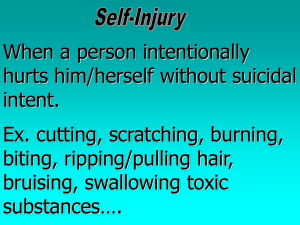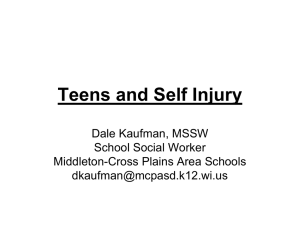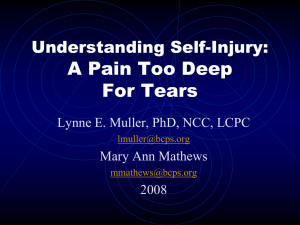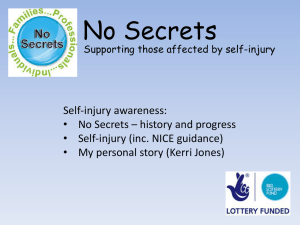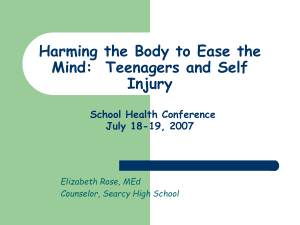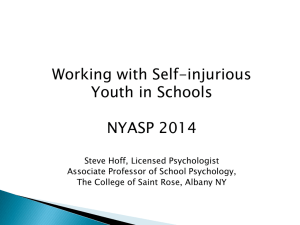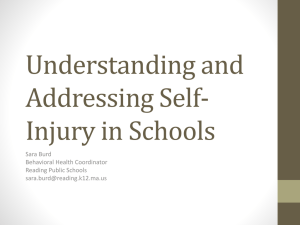Document 11168038
advertisement
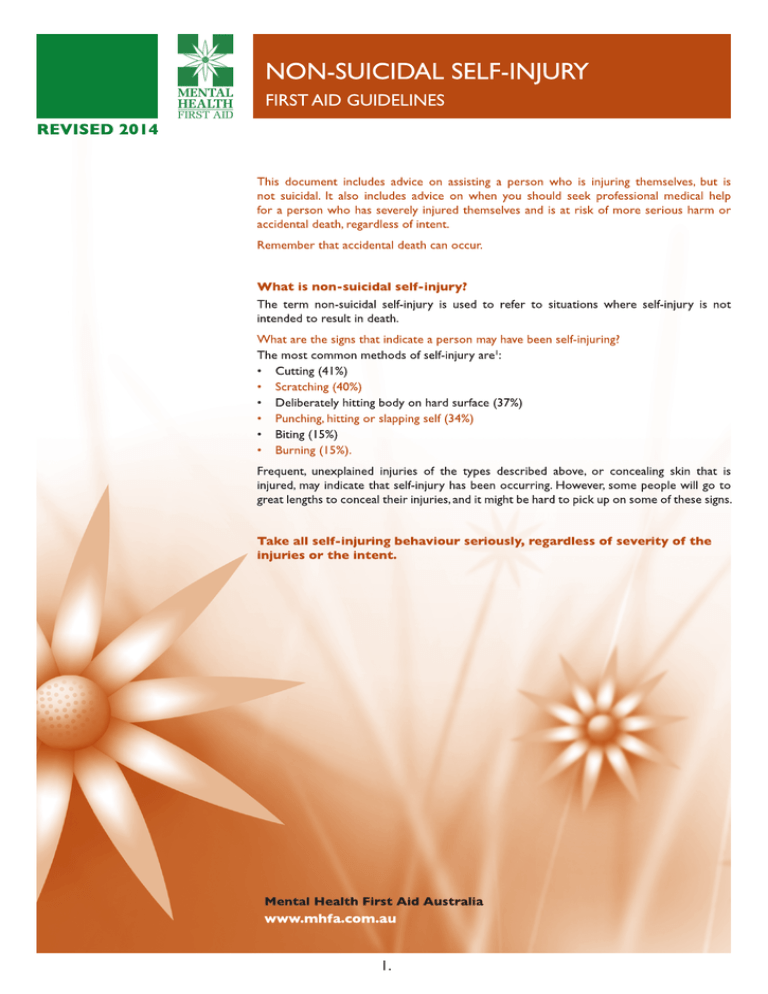
NON-SUICIDAL SELF-INJURY FIRST AID GUIDELINES (Revised 2014) How common is non-suicidal self-injury? What types of professional help are available for non-suicidal self-injury? What should I do if I find someone injuring themselves? An Australian national survey in 20081 found that 2.6% of people aged 10 or over had engaged in non-suicidal self-injury in the past year, and 8.1% had done so at some point in their life. Although it can occur at any age, self-injury is most common in adolescents and young adults. About 5% of 10-17 year olds and 7% of 18-24 year olds have deliberately injured themselves in the past year. The median age of onset of selfinjury is 17 years. Self-injury is slightly more common in women than in men. Mental healthcare professionals, such as a GP, psychologist, psychiatrist, school counsellor, are all able to provide appropriate assistance to help someone who is engaging in selfinjury. Mental health services, including suicide helplines, and other mental health community groups are also able to provide support and assistance. If you have interrupted someone who is in the act of deliberate self-injury, intervene in a supportive and non-judgmental way. Although it is natural to feel upset, helpless and even angry upon finding out someone self-injures, try to remain calm and avoid expressions of shock or anger.Tell the person that you are concerned about them and ask whether you can do anything to alleviate the distress. Ask if medical attention is needed. Why do people engage in non-suicidal self-injury? People self-injure for many reasons. These include1: • To manage painful feelings (57%) • To punish oneself (25%) • To communicate with others (6%) • Other reasons (58%). Less than 3% cited their reason as combating suicidal thoughts, seeking a rush or high, or to deliberately scar themselves. Self-injury is rarely used as a means of seeking attention due to the intense shame most people feel about their wounds and scars. What is the relationship between non-suicidal self-injury and suicide? People who engage in non-suicidal self-injury are at higher risk of a suicide attempt. About 10% of people who had injured themselves in the last four weeks had made a suicide attempt in the last year, and about 60% had had thoughts of suicide. This shows that people who engage in non-suicidal self-injury may at other times engage in self-injury with the intention of dying. It is not always easy to tell the difference between non-suicidal self-injury and a suicide attempt. Do not assume that people who self-harm are suicidal. The only way to know is to ask the person directly if they are suicidal. If they say yes, you should refer to “Suicidal thoughts and behaviours: first aid guidelines2”. What are the physical and mental health risks of self-injury? Injuries to the skin often go untreated (e.g., people may be unwilling to seek sutures for wounds or may not undertake good wound care to keep injuries from becoming infected), meaning they can take a long time to heal, and there may be complications from infection. Hitting body parts against hard surfaces may result in small fractures which may become complicated if untreated. Over time, self-injury can become the central strategy for coping with problems, making it very hard to use more adaptive ways of coping. For some people, self-injury can be a very difficult habit to break. What should I do if I suspect someone is self-injuring? If you suspect that someone you care about is deliberately injuring themselves, you need to discuss it with them. Before talking to the person, acknowledge and deal with your own feelings about self-injuring behaviours. If you feel you are unable to talk to the person who is self-injuring, try to find someone else who can talk to them. Choose a private place for the conversation. Directly express your concerns that the person may be injuring themselves. Ask about self-injury in a way that makes it clear to the person that you understand a bit about self-injury, e.g. “Sometimes, when people are in a lot of emotional pain, they injure themselves on purpose. Is that how your injury happened?”. Self-injury is a very private thing and is hard to talk about. Do not demand to talk about things the person is not ready to discuss.You should avoid expressing a strong emotional response of anger, fear, revulsion or frustration. If the person is receiving psychiatric care, ask if their treating professional knows about the injuries. 2. How should I talk with someone who is deliberately injuring themselves? Keep in mind that ‘stopping self-injury’ should not be the focus of the conversation. Instead, look at what can be done to make the person’s life more manageable, or their environment less distressing. Understand that self-injury cannot be stopped overnight, and people will need time to recover and learn healthy coping mechanisms. Behave in a supportive and non-judgmental way. Understand that self-injury makes the person’s life easier and accept their reasons for doing it. Be supportive without being permissive of the behaviour. Be aware of what your body language is communicating about your attitudes. Use a calm voice when talking to the person. Avoid expressing anger or a desire to punish the person for self-injuring. Be comfortable with silence, allowing the person time to process what has been talked about. Be prepared for the expression of intense emotions. What should I say? Express concern & actively listen Use ‘I’ statements instead of ‘you’ statements (e.g. “I feel worried/angry/frustrated when you…” instead of “You make me feel worried/angry/frustrated…”) when talking with the person. Ask the person questions about their self-injury, but avoid pressuring them to talk about it. Reflect what the person is saying by acknowledging their experience as they are describing it. Give support & reassurance Express empathy for how the person is feeling. Validate the person’s emotions by explaining that these emotions are appropriate and valid. Let them know they are not alone and that you are there to support them. Work NON-SUICIDAL SELF-INJURY FIRST AID GUIDELINES (Revised 2014) collaboratively with the person in finding solutions (i.e. by finding out what they want to happen, and discussing any possible actions with them). Reassure the person that there are sources of help and support available. Tell the person that you want to help, and let them know the ways in which you are willing to help them. Don’t promise the person that you will keep their self-injury a secret. If you need to tell somebody about the person’s self-injury to keep them safe, speak to them about this first. Avoid gossiping or talking to others about it without their permission. BOX A: Things to avoid when talking with someone about deliberate self-injury Don’t… • … minimise the person’s feelings or problems. • … use statements that don’t take the person’s pain seriously (such as “but you’ve got a great life” or “things aren’t that bad”). • … try to solve the person’s problems for them. • … touch (e.g. hug or hold hands with) the person without their permission. • ... use terms such as ‘self-mutilator’, ‘self-injurer’, or a ‘cutter’ to refer to the person. • ... accuse the person of attention seeking. • ... make the person feel guilty about the effect their self-injuring is having on others • ... set goals or pacts, such as “If you promise not to hurt yourself between now and next week, you’re doing really well”, unless the person asks you to do this. • ... try to make the person stop selfinjuring (e.g. by removing self-injury tools) or giving them ultimatums (i.e. “If you don’t stop self-injuring, you have to move out”). • … offer drugs, prescription pills or alcohol to the person. What do I do if the person is not ready to talk? Respect the person’s right not to talk about their self-injuring. If the person doesn’t want to talk right away, let them know that you want to listen to them when they are ready. Ask the person what would make them feel safe enough to be able to discuss their feelings. Do not force the issue unless the injury is severe. If the person still doesn’t want to talk, ask a health professional for advice on what to do. How can I help the person engaging in non-suicidal self-injury? Seeking professional help Self-injury is often a symptom of a mental health problem that can be treated. Encourage the person to seek professional help. Let them remain in control over seeking help as much as possible. Suggest and discuss options for getting help rather than directing the person what to do. Help the person map out a plan of action for seeking help. Talk about how you can help them to seek treatment and who they can talk to, e.g. a mental health service or a mental health professional. Provide praise for any steps the person takes towards getting professional help. Follow-up with the person to check whether they have found professional help that is suitable for them. You should seek mental health assistance on the person’s behalf if: • The person asks you to • The injury is severe or getting more severe, such as cuts getting deeper or bones being broken • The self-injurious behaviour is interfering with daily life • The person has injured their eyes • The person has injured their genitals • The person has expressed a desire to die. Keep in mind that not all people who selfinjure want to change their behaviour. Even though you can offer support, you are not responsible for the actions or behaviour of someone else, and cannot control what they do. 3. If the person is an adolescent, a more directive approach may be needed. Help the adolescent map out a plan of action for seeking help and offer to go along with them to an appointment. When is emergency medical attention necessary? Avoid over-reacting; medical attention is only required if the injury is severe. Contact emergency services if a wound or injury is serious. Any cut which is gaping requires medical attention, as it may need stitches. Any burn which is two centimetres or larger in diameter, and any burn on the hands, feet or face requires medical attention. If the person has harmed themselves by taking an overdose of medication or consuming poison, call an ambulance, as the risk of death or permanent harm is high. Deliberate overdose is more frequently intended to result in death, but is sometimes a form of self-injury. Regardless of a person’s intentions, emergency help must be sought. Encouraging alternatives to self-injury Encourage the person to seek other ways to relieve their distress. Help the person to use their coping strategies that do not involve self-injuring, and help them to make a plan about what to do when they feel like self-injuring. Suggest some coping strategies and discuss with the person what might be helpful for them. Encourage the use of any positive coping strategy which helps them to get through the urge to self-injure. Encourage the person to share their feelings with other people, such as a close friend or family member, when they are feeling distressed or have the urge to self-injure. Help the person think of ways to reduce their distress, for example, having a hot bath, listening to loud music, or doing something kind for themselves. Offer the person information materials (e.g. a website or factsheet) about alternatives to self-injury. NON-SUICIDAL SELF-INJURY FIRST AID GUIDELINES (Revised 2014) An important note: Self-injury can indicate a number of different things. Someone who is hurting themselves may be at risk of suicide. Others engage in a pattern of self-injury over weeks, months or years and are not necessarily suicidal.These guidelines are to assist you if the person you are helping is not suicidal, but is injuring themselves for other reasons. If the person you are assisting is suicidal, please refer to the guidelines entitled First aid for Suicidal thoughts and behaviours. Purpose of these Guidelines These guidelines are designed to help members of the public to provide first aid to someone who is deliberately injuring themselves, but is not suicidal.The role of the first aider is to assist the person until appropriate professional help is received or the crisis resolves. Development of these Guidelines The following guidelines are based on the expert opinions of a panel of mental health consumers and professionals from Australia, New Zealand, the UK, the USA and Canada about how to help someone who may be deliberately injuring themselves. Details of the methodology can be found in: Ross AM, Jorm AF, Kelly CM. Re-development of mental health first aid guidelines for deliberate non-suicidal self-injury: A Delphi study. How to use these Guidelines These guidelines are a general set of recommendations about how you can help someone who may be deliberately injuring themselves. Each individual is unique and it is important to tailor your support to that person’s needs.These recommendations therefore may not be appropriate for every person who is deliberately injuring themselves. Also, the guidelines are designed to be suitable for providing first aid in developed English-speaking countries. They may not be suitable for other cultural groups or for countries with different health systems. Although these guidelines are copyright, they can be freely reproduced for non-profit purposes provided the source is acknowledged. Please cite the guidelines as follows: Mental Health First Aid Australia. Non-suicidal self-injury: first aid guidelines (Revised 2014). Melbourne: Mental Health First Aid Australia; 2014. Enquiries should be sent to: Mental Health First Aid Australia email: mhfa@mhfa.com.au References 1. Martin, G., Swannell, S., Harrison, J., Hazell, P., & Taylor, A. (2010). The Australian National Epidemiological Study of Self-Injury (ANESSI). Centre for Suicide Prevention Studies: Brisbane, Australia. 1403_Web_KJ 2. Mental Health First Aid guidelines for suicidal thoughts and behaviours. Available from: www.mhfa.com.au/cms/ mental-health-first-aid-guidelines-project/ All MHFA guidelines can be downloaded from www.mhfa.com.au 4.

